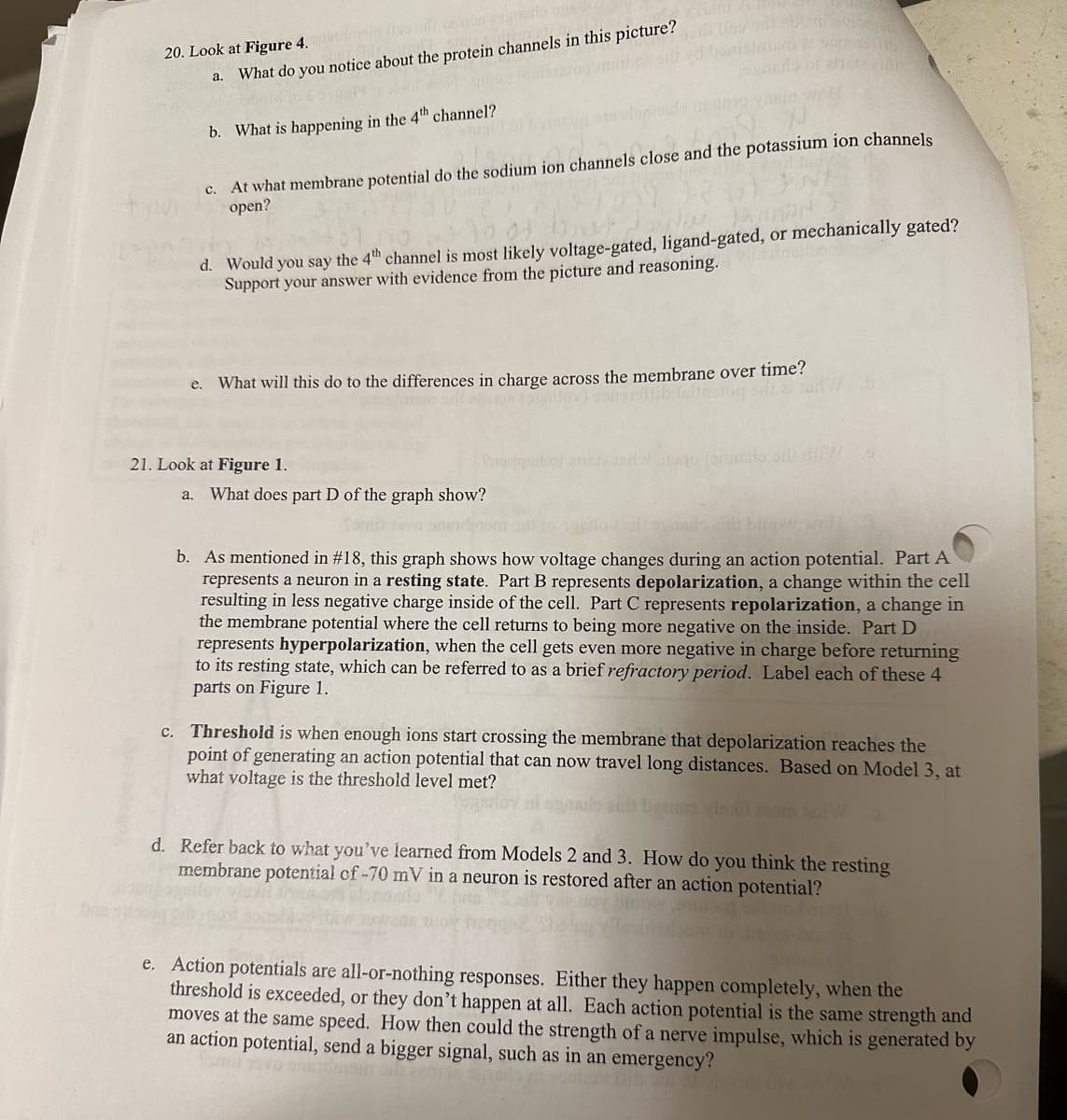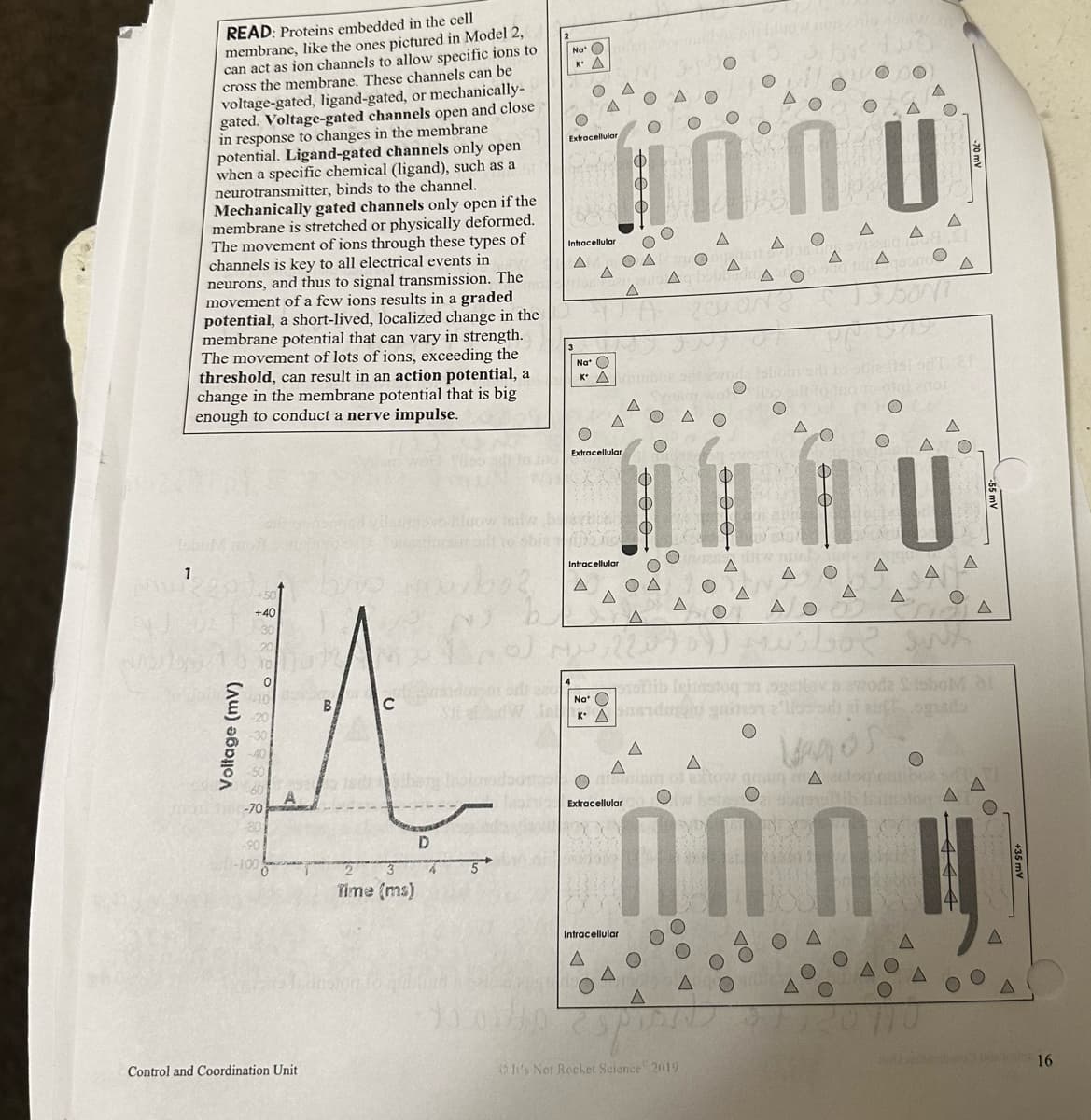20. Look at Figure 4.gadmpin so om What do you notice about the protein channels in this picture? b. What is happening in the 4th channel? Prents C. At what membrane potential do the sodium ion channels close and the potassium ion channels open? 69 d. Would you say the 4th channel is most likely voltage-gated, ligand-gated, or mechanically gated? Support your answer with evidence from the picture and reasoning.
20. Look at Figure 4.gadmpin so om What do you notice about the protein channels in this picture? b. What is happening in the 4th channel? Prents C. At what membrane potential do the sodium ion channels close and the potassium ion channels open? 69 d. Would you say the 4th channel is most likely voltage-gated, ligand-gated, or mechanically gated? Support your answer with evidence from the picture and reasoning.
Human Physiology: From Cells to Systems (MindTap Course List)
9th Edition
ISBN:9781285866932
Author:Lauralee Sherwood
Publisher:Lauralee Sherwood
Chapter3: The Plasma Membrane And Membrane Potential
Section: Chapter Questions
Problem 2TAHL: Assume that a membrane permeable to Na+ but not to Cl- separates two solutions. The concentration of...
Related questions
Question
Need help with Anatomy homework

Transcribed Image Text:20. Look at Figure 4.pandom so odk
a. What do you notice about the protein channels in this picture?
b. What is happening in the 4th channel?
c. At what membrane potential do the sodium ion channels close and the potassium ion channels
open?
19
d. Would you say the 4th channel is most likely voltage-gated, ligand-gated, or mechanically gated?
Support your answer with evidence from the picture and reasoning.
e. What will this do to the differences in charge across the membrane over time?
21. Look at Figure 1.
AUST
eidi
a. What does part D of the graph show?
Sami 19va 50m
maq lonneilo odl dir/
b. As mentioned in #18, this graph shows how voltage changes during an action potential. Part A
represents a neuron in a resting state. Part B represents depolarization, a change within the cell
resulting in less negative charge inside of the cell. Part C represents repolarization, a change in
the membrane potential where the cell returns to being more negative on the inside. Part D
represents hyperpolarization, when the cell gets even more negative in charge before returning
to its resting state, which can be referred to as a brief refractory period. Label each of these 4
parts on Figure 1.
c. Threshold is when enough ions start crossing the membrane that depolarization reaches the
point of generating an action potential that can now travel long distances. Based on Model 3, at
what voltage is the threshold level met?
d. Refer back to what you've learned from Models 2 and 3. How do you think the resting
membrane potential of -70 mV in a neuron is restored after an action potential?
e. Action potentials are all-or-nothing responses. Either they happen completely, when the
threshold is exceeded, or they don't happen at all. Each action potential is the same strength and
moves at the same speed. How then could the strength of a nerve impulse, which is generated by
an action potential, send a bigger signal, such as in an emergency?

Transcribed Image Text:READ: Proteins embedded in the cell
membrane, like the ones pictured in Model 2,
can act as ion channels to allow specific ions to
cross the membrane. These channels can be
voltage-gated, ligand-gated, or mechanically-
gated. Voltage-gated channels open and close
in response to changes in the membrane
potential. Ligand-gated channels only open
when a specific chemical (ligand), such as a
neurotransmitter, binds to the channel.
Mechanically gated channels only open if the
membrane is stretched or physically deformed.
The movement of ions through these types of
channels is key to all electrical events in
neurons, and thus to signal transmission. The
movement of a few ions results in a graded
potential, a short-lived, localized change in the
membrane potential that can vary in strength.
The movement of lots of ions, exceeding the
threshold, can result in an action potential, a
change in the membrane potential that is big
enough to conduct a nerve impulse.
1
+40
30
10724
B.
M
-20
-70
Voltage (mv)
Control and Coordination Unit
Time (ms)
D
4
all to ino
Jal
Na O
KA
malan
Extracellular,
Intracellular
A
Annu
A
Na* O
KAibo ad
Extracellular
Intracellular
A
A
A
OA
O
Extracellular
Intracellular
A
A
0 0
0 0
ooo
A
prohib
Na O
KA pasrdagin
A O
A
It's Not Rocket Science 2019
VIN
A
spren
O
O
O
ΔΟ
104
OF CURE
O
TIAN
A
BRAND
Vagos
A
A
A
om of extow ang ▲alog cone SED
Ol betest
O
Oarsoamultits fritraton A
A
n
A
INTYY
A
0
A
SNA
wode SloboM d
auft ogutdo
A
O
+35 mV
16
Expert Solution
This question has been solved!
Explore an expertly crafted, step-by-step solution for a thorough understanding of key concepts.
This is a popular solution!
Trending now
This is a popular solution!
Step by step
Solved in 4 steps with 1 images

Knowledge Booster
Learn more about
Need a deep-dive on the concept behind this application? Look no further. Learn more about this topic, biology and related others by exploring similar questions and additional content below.Recommended textbooks for you

Human Physiology: From Cells to Systems (MindTap …
Biology
ISBN:
9781285866932
Author:
Lauralee Sherwood
Publisher:
Cengage Learning

Human Physiology: From Cells to Systems (MindTap …
Biology
ISBN:
9781285866932
Author:
Lauralee Sherwood
Publisher:
Cengage Learning